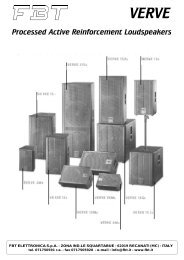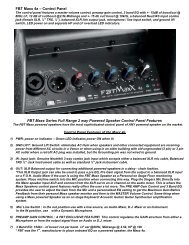A B B c - FBT USA
A B B c - FBT USA
A B B c - FBT USA
Create successful ePaper yourself
Turn your PDF publications into a flip-book with our unique Google optimized e-Paper software.
BREVI CENNI DI ACUSTICA BRIEF NOTES ON ACOUSTICS<br />
Adattare l’impedenza di uscita del finale di potenza a<br />
quella degli speakers significa fare in modo che tutta<br />
l’energia emessa dal finalevenga trasferitaalle casse<br />
senza perdita di segnale equindi far funzionare il<br />
sistema al meglio delle sue possibilità (ed evitare<br />
danni); una cassa con impedenza superiore aquella<br />
delfinalepuòessereutilizzataascapitodellapotenza,<br />
mentre èbene evitare collegamenti con casse che<br />
hannoimpedenzaminoreaquelladelfinaledipotenza.<br />
Usando sistemi più complessi (ad esempio più<br />
speaker collegati allo stesso finale) bisogna fare in<br />
modo che il valore totale dell’impedenza degli<br />
altoparlanti sia corrispondente aquella presente sul<br />
finale.<br />
Possiamo avereduetipi di collegamento:inserieoin<br />
parallelo.<br />
Collegare in serie due altoparlanti significa unire un<br />
terminalepositivoedunonegativodeidueecollegare<br />
all’amplificatore i rimanenti due terminali rimasti<br />
scollegati.Ilorovalorisi sommano:per esempio,due<br />
altoparlantida8ohminseriedanno16ohm.<br />
Quando gli altoparlanti sono collegati in parallelo, i<br />
terminali dello stesso segno sono uniti tra loro. Per<br />
ottenereilvaloretotalebisognautilizzareunaformula,<br />
indicando conR1 ed R2 ivaloridi duealtoparlanti,ed<br />
eseguire.(R1xR2)/(R1+R2).Conduealtoparlanti<br />
da8ohm,peresempio,avremo:<br />
(8x8) /(8+8) =64/16 =4ohm. In pratica collegando<br />
duealtoparlantiugualiinparalleloilvaloresidimezza.<br />
Un diffusore può essere utilizzato sia in impianti di<br />
sonorizzazioneatensionecostante siainimpiantiad<br />
impedenzacostante.<br />
IMPIANTIATENSIONECOSTANTE<br />
(1) La tensione di ingresso selezionata sul diffusore<br />
deve corrispondere con la tensione selezionata<br />
sull’uscitadell’amplificatore<br />
(2)Lasommadellepotenzenominalidituttiidiffusori<br />
collegatinondevesuperarequelladell’amplificatore<br />
IMPIANTIADIMPEDENZACOSTANTE<br />
(1)L’impedenzadicaricocomplessivadituttiidiffusori<br />
collegati non deve essere inferiore all’impedenza<br />
selezionata sull’uscita dell’amplificatore, per non<br />
rischiaredidanneggiareseriamentequest’ultimo<br />
(2)Lasommadellepotenzenominalidituttiidiffusori<br />
collegati non deve essere inferiore a quella<br />
dell’amplificatore<br />
(3)Lalunghezzadeicavidicollegamentodeveessere<br />
ridottaalminimo<br />
21<br />
Adaptingtheoutputimpedanceofthepoweramplifier<br />
totheloudspeakerinputimpedancemeansthatallthe<br />
energy from the amplifier will be transferred to the<br />
speakers with no signal losses, so that the system<br />
functions in optimum conditions (and the risk of<br />
damage is minimised); a loudspeaker of higher<br />
impedance than the power amplifier can be used<br />
although this will result in a power reduction;<br />
loudspeakers of lower impedance than the power<br />
amplifieroutputimpedanceshouldnotbeconnected.<br />
If more complex systems (e.g. several speakers<br />
connectedtothesamepoweramplifier)areadopted,it<br />
must be ensured that the overall speaker impedance<br />
value corresponds to the power amplifier output<br />
impedance.<br />
Therearetwopossibleconnectionsystems:seriesor<br />
parallel.<br />
Connectingtwo speakersinseriesmeansconnecting<br />
the positive terminal of one speaker to the negative<br />
terminal of the other and then connecting the two<br />
remaining unconnected terminals to the amplifier. In<br />
thiscasetheimpedancevaluesaresummed:e.g.two8<br />
ohm speakersconnected inparallel presenta16 ohm<br />
load.<br />
To connect two speakers in parallel simply<br />
interconnectthetwosignspeakerterminals.Toobtain<br />
the total value in this case acalculation is required<br />
whereinR1andR2aretheloudspeakervaluesandthe<br />
following formula isresolved: (R1 xR2 )/(R1 +R2 ).<br />
Forexample,withtwo8-ohmspeakers,wewouldhave:<br />
(8x8) /(8+8) =64/16 =4ohm. In practice, when two<br />
identical speakers are connected in parallel the<br />
impedancevalueishalved.<br />
Aspeakercanbeusedbothinconstantvoltagesound<br />
systemsandconstantimpedancesystems.<br />
CONSTANTVOLTAGESYSTEMS<br />
(1) The input voltage selected on the speaker must<br />
correspond to the voltage selected on the amplifier<br />
output<br />
(2) The sum of the nominal power values of all the<br />
connected speakers must not exceed that of the<br />
amplifier<br />
CONSTANTIMPEDANCESYSTEMS<br />
(1) The total load impedance of all the connected<br />
speakersmustbenolessthantheimpedanceselected<br />
on the amplifier output to avoid the risk of serious<br />
damagetotheamplifier<br />
(2) Thesum of nominal power valuesof all connected<br />
speakersmustbenolessthanthatoftheamplifier<br />
(3) Connection cable lengths must be kept to the<br />
indispensableminimum





